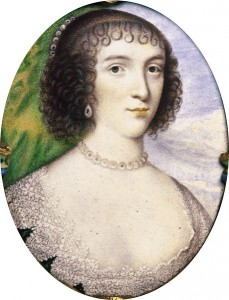The question is often raised as to whether grief is a universal experience or whether it is culturally influenced. Clearly the latter is true. However there is no culture in the world that does not feel the pain of loss. These excerpts from letters written 380 years ago indicate that a man’s grief for his wife is little changed, save for the language style and spelling. I have retained the spelling from the original document. All the words are recognisable, so long as you remember that a v is replaced with a u and vice versa. Also the modern j appeared as an i. Some words you will notice are abbreviated.
On May Day 1633, Venetia Stanley an heiress of the Estates of the Percy family of the Earldom of Northumberland died suddenly. Her husband, Sir Kenelm Digby, found her dead in bed. Perhaps due to court gossip that Sir Kenelm had unwittingly given her a fatal elixir for her health, the King, Charles I ordered a post mortem, which revealed:
“the braine much putrifyed and corrupted: all the cerebellum was rotten, and retained not the forme of braine but was meere pus and corrupted matter.”
(Gabrieli, 1955 Vol 9 No.2, p.134)
The rest of her organs were however free of disease, although by contemporary accounts she had been kept in a warm room for some days. The eminent physicians and surgeons, who attended, concluded:
“that the decay they found there was not the worke of short time, but had bin some yeares in growing to this passe; and yet she neuer in her life was troubled wth the least paine in the head; and all the faculties of her braine she exercised.”
(Gabrieli, 1955 Vol 9 No 2 p.134)
We have to thank for the quality of the public record, letters which Sir Kenelm wrote to his friends and family during his mourning. These were faithfully copied into print by Professor Vittorio Gabrieli between 1955 and 1957 and published in The National Library of Wales Journal as A New Digby Letterbook: In Praise of Venetia. (Gabrieli, 1955, 1956, 1957). These letters provide an intriguing glimpse into one man’s grief. They are now digitised and available to all on The National Library of Wales web pages.
Three weeks after his wife died, Sir Kenelm wrote a long and moving letter to his sons, extolling her virtues, rather as a father might do now, for children too young to understand so that in time they will have an impression of their mother. The extract above is from that letter. He also wrote to his brother on the same day, 17 days after his loss:
“…alas in this solitude where I am I can haue no rest of truce wth my corroding and endelesse thoughts. I cast wth my selfe how happy I once was, the losse of wch state taketh me so much more miserable as sicknesse is more felt then health, paine then quiett and ease, and as sorrow contracteth the heart more then ioy can dilate it”.
(Gabrieli, 1955 Vol 9 No 2, p.137)
Writing to his brother a week later, he recalled his immediate grief reaction following Venetia’s death:
“For four dayes together I did nothing but weepe (as you can well wittnesse)”.
(Gabrieli, 1956 Vol 9 No. 4, p. 450).
He wrote of his difficulty in concentrating:
“Neuer since my wife dyed, I haue bin able to looke vpon a booke to any purpose; and if I force my selfe to reade a few lines, I vnderstand them not, although the matter be neuer so plaine”.
(Gabrieli, 1956 Vol 9 No.4, p.460).
He wrote of his struggle to enjoy anything, even though as a wealthy man, life was comfortable:
“The seate and ayre is excellent good and wholesome, the house, neate and conuenient; and the garden richly adorned with all variety of beautifull flowers, fine walkes and arbors, and hath a pleasant riuer with seuerall Meanders and stored with dainty fish running through it.
But alas, what is all this to me, whose heart is not capable of ioy or truce from griefe?”
(Gabrieli, 1956 Vol 9 No.4, p.446).
Sir Kenelm reported his loss of appetite (9, 4, p.450) and of tears “suddaine come pouring from my eyes” (9, 4, p.450). He wrote of the guilt of his marital infidelity (9, 4, p. 448), of the belief that her death was God’s punishment to him (9, 4, p. 448). He noted near hallucinatory experiences:
“I can sometimes fansie to my selfe particular passages betweene my wife and me so strongly yt me thinkes they are euen then present wth me; I see her and I talke wth her. But in the end all this serueth but to encrease my feauour. When I see they are but vaine shaddowes of what is lost and neuer can be recouered again,”
(Gabrieli, 1955 Vol 9 No.2, p.138)
After 6 months he reported; “I lye quietly vpon the ground and am contented with my fall, it lyeth gently vpon me” (10, 1, p.93). Just over a year after her death, in June 1634 he began to be more realistic about his eulogy and able to admit “any human infirmity in her” (Gabrieli, 1957 Vol 10, No.1 p.99). He had himself painted several times in mourning clothes (Gittings, 1995). When he died he was, at his own request, buried with his wife (Jupp & Gittings, 1999, p. 166).
References
Gabrieli, V. (1955). A New Digby Letter-Book: In Praise of Venetia. The National Library of Wales Journal, 9(2), 113-148.
Gabrieli, V. (1956). A New Digby Letter-Book: In Praise of Venetia. The National Library of Wales Journal, 9(4), 440-462.
Gabrieli, V. (1957). A New Digby Letter-Book: In Praise of Venetia. The National Library of Wales Journal, 10(1), 81-106.
Gittings, C. (1995). Venetia’s Death and Kenelm’s Mourning. In A. Sumner (Ed.), Death, Passion and Politics (pp. 54-68). London: Dulwich Picture Gallery.
Jupp, P. C., & Gittings, C. (1999). Death in England. Manchester University Press:
The pictures:
Venetia Stanley, Lady Digby, (1600-1633) painted enamel on gold, by Henri Toutin.
Sir Kenelm Digby 1603-1665. Oil on canvas by Anthony van Dyck (1599–1641)
Both pictures from Wikipedia Commons
A painting of Venetia on her deathbed is in the Dulwich Picture Gallery, and a copy can be found here:

